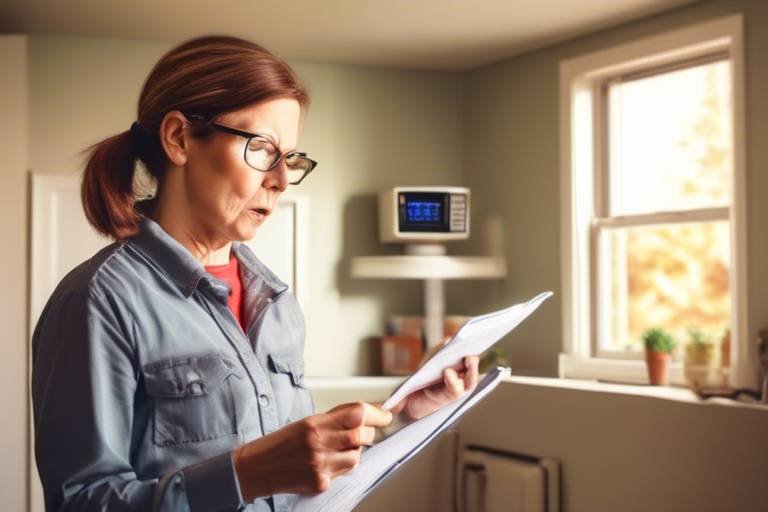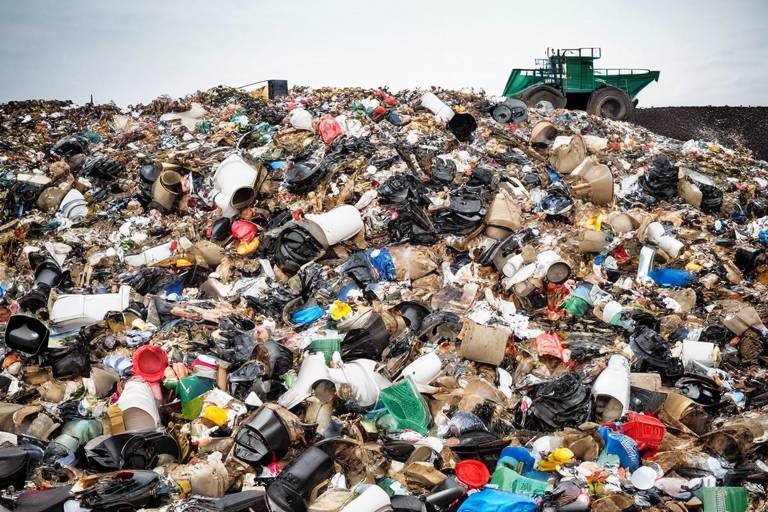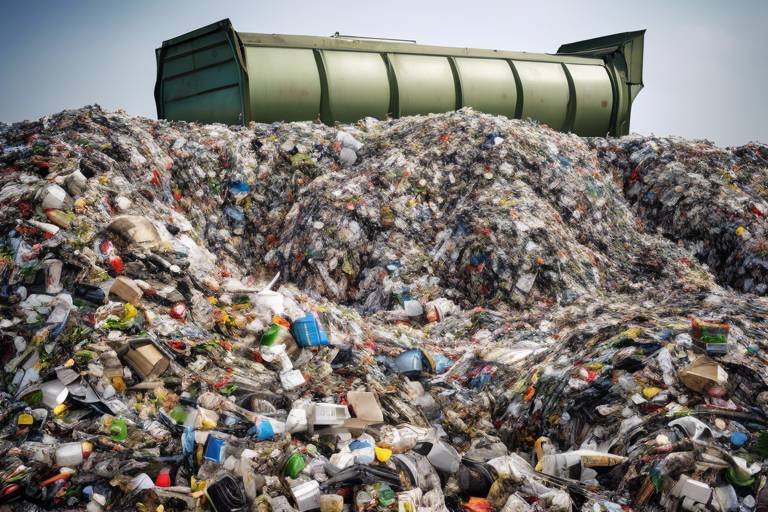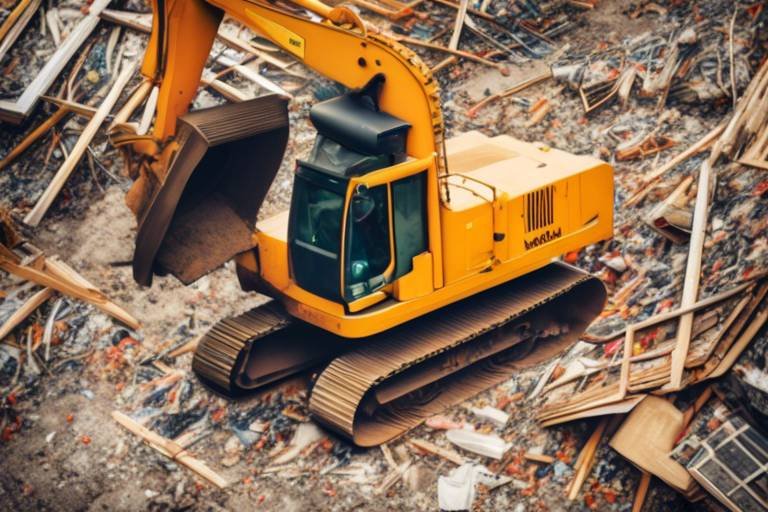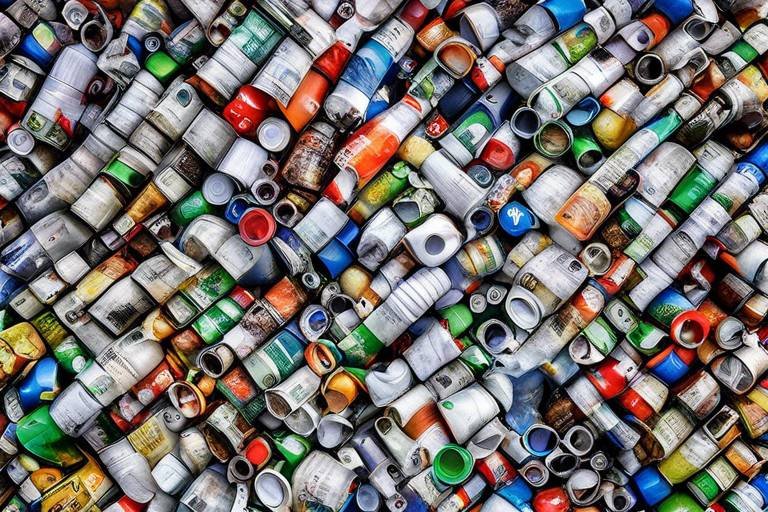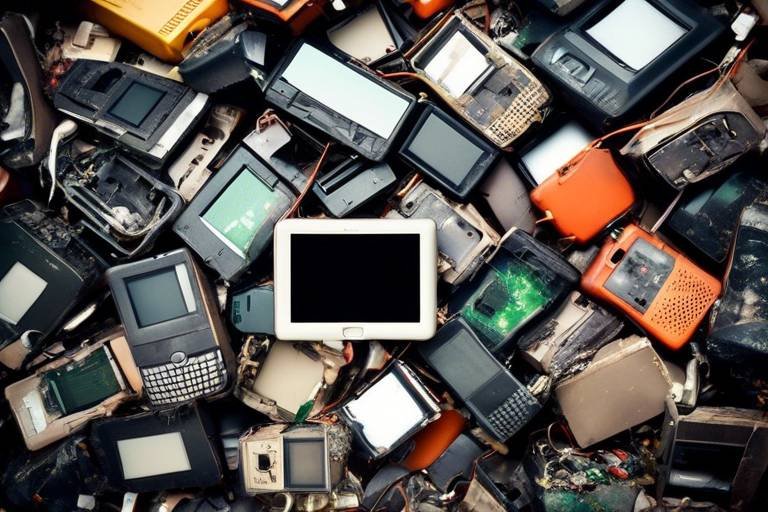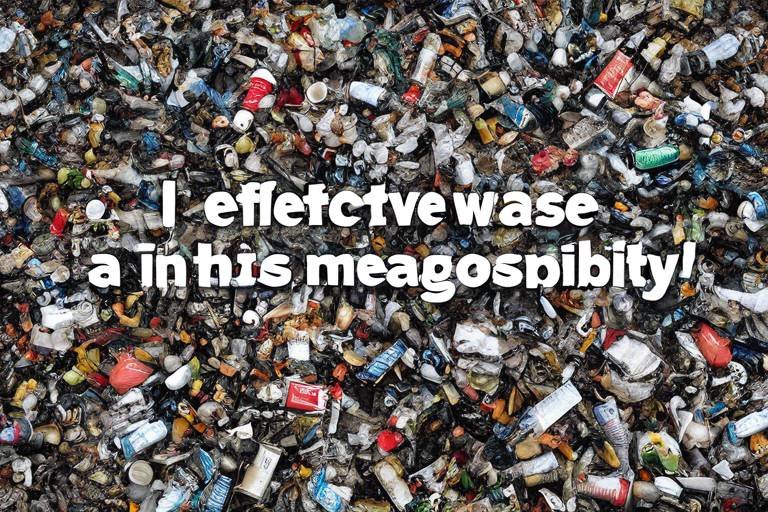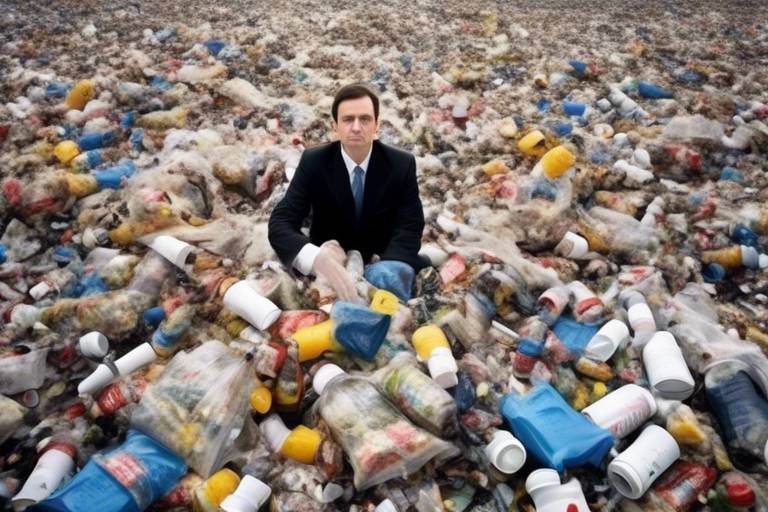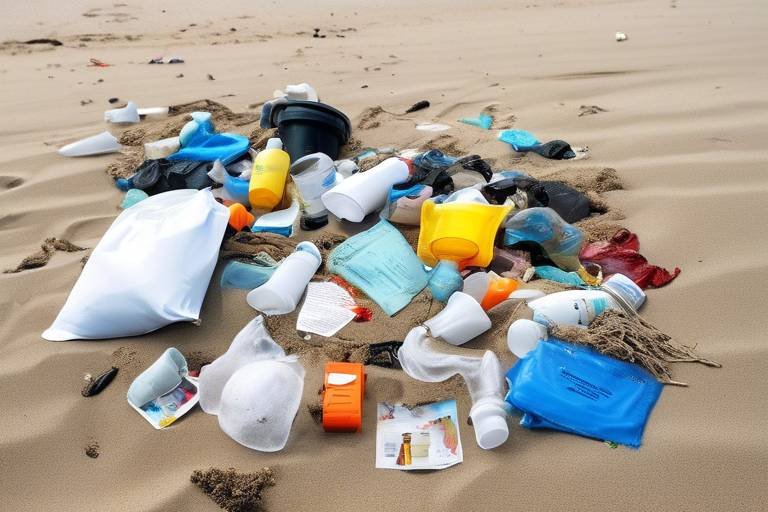Household Hacks to Reduce Plastic Use
In today's world, where plastic pollution is becoming a pressing issue, it's essential to explore effective strategies and innovative ideas to minimize plastic consumption in your daily life. Not only does reducing plastic use contribute to a healthier planet, but it also allows you to maintain convenience and practicality in your everyday routines. Imagine a lifestyle where you can enjoy the benefits of modern living while being a champion for the environment. Sounds appealing, right? Let’s dive into some household hacks that can help you achieve just that!
When it comes to cutting down on plastic, one of the most impactful changes you can make is to switch to reusable alternatives. Think about it: every time you grab a plastic bag or a single-use bottle, you're contributing to the mountain of waste that ends up in landfills and oceans. Instead, consider investing in high-quality, reusable products that can take their place. From sturdy shopping bags made of canvas to stainless steel water bottles that keep your drinks cold for hours, the options are endless. Not only do these alternatives help the environment, but they also save you money in the long run. Plus, you’ll feel good knowing you’re making a difference!
Another fantastic way to reduce plastic use is by creating your own household items using sustainable materials. This not only cuts down on plastic reliance but also promotes creativity and self-sufficiency in your home. Imagine whipping up your own cleaning supplies or crafting unique decor pieces from items you would otherwise throw away. It’s like turning trash into treasure! You’ll be surprised at how easy and fun it can be.
Let’s start with homemade cleaning supplies. Why spend a fortune on commercial cleaners that come in plastic bottles when you can make your own with simple ingredients? Not only are these DIY solutions often more effective, but they are also free from harmful chemicals. Here are a couple of easy recipes:
- All-Purpose Cleaner: Mix equal parts of water and vinegar in a spray bottle. Add a few drops of essential oil for a pleasant scent.
- Baking Soda Scrub: Combine baking soda with a bit of water to create a paste for scrubbing surfaces.
These homemade cleaners not only keep your space sparkling clean but also significantly reduce plastic packaging waste.
When creating your own cleaning supplies, it’s crucial to choose eco-friendly ingredients. Common household items like vinegar, baking soda, and lemon juice can work wonders. They are not only effective but also safe for your family and pets. By using these natural ingredients, you’re minimizing your plastic waste while ensuring a clean and healthy living space.
Now that you’ve made your own cleaning supplies, how do you store them? Invest in reusable glass or metal containers instead of plastic ones. Not only do these materials last longer, but they also look great on your shelves. Plus, you can label them to keep everything organized. This simple switch can further decrease your plastic use and promote sustainable practices in your household.
Have you ever thought about turning your old plastic items into something useful? Upcycling is a brilliant way to repurpose materials that would otherwise end up in the trash. For example, old plastic containers can become planters, and worn-out t-shirts can be transformed into reusable shopping bags. The possibilities are endless! Not only does this reduce overall plastic consumption, but it also sparks creativity and can even be a fun family activity.
Making informed purchasing decisions is another powerful way to reduce plastic use. When you head to the store, take a moment to consider the packaging of the products you’re buying. Are they wrapped in plastic? Do they come in glass or cardboard instead? By prioritizing sustainable products, you can avoid plastic packaging and support eco-friendly brands. It’s all about making conscious choices that align with your values.
One effective strategy is to buy in bulk. Not only does this minimize packaging waste, but it also allows you to stock up on essentials without constantly running to the store. Think about it: buying a large container of rice or oats reduces the number of small plastic bags you’d typically use. Plus, bulk buying often saves you money!
Finally, seek out brands that prioritize sustainability. Many companies now offer plastic-free alternatives, from personal care products to food items. By supporting these brands, you empower businesses that align with your values and contribute to a greener future. It’s a win-win situation!
Q: What are some easy swaps to reduce plastic in my kitchen?
A: Start by using reusable shopping bags, glass food storage containers, and beeswax wraps instead of plastic wrap.
Q: How can I encourage my family to reduce plastic use?
A: Lead by example! Show them how fun and rewarding it can be to create DIY items and make eco-friendly choices together.
Q: Are there any apps that can help me find eco-friendly products?
A: Yes! Apps like "Think Dirty" and "GoodGuide" can help you find sustainable products and avoid those with excessive plastic packaging.

1. Reusable Alternatives
In today’s fast-paced world, the convenience of single-use plastics often overshadows the environmental consequences they bring. However, adopting reusable alternatives can be a game-changer, not just for the planet but also for your daily routine. Imagine swapping out those flimsy plastic bags for durable, stylish tote bags that not only look good but also serve a purpose. With a little effort, you can make choices that are both practical and sustainable.
Think about the last time you reached for a bottled drink. Instead of contributing to the plastic waste crisis, consider investing in a high-quality, reusable water bottle. These come in a variety of materials, including stainless steel and glass, and can keep your beverages hot or cold for hours. Plus, they’re a great conversation starter! When friends see you with a sleek, reusable bottle, it might inspire them to make the switch too.
Furthermore, food storage is another area where you can make a significant impact. Instead of using plastic wrap, why not try beeswax wraps? These eco-friendly alternatives are not only biodegradable but also come in vibrant patterns that can brighten up your kitchen. You can even make your own at home, adding a personal touch to your sustainable efforts.
Here’s a quick comparison of common single-use plastics and their reusable counterparts:
| Single-Use Plastic | Reusable Alternative |
|---|---|
| Plastic Bags | Reusable Tote Bags |
| Bottled Water | Reusable Water Bottles |
| Plastic Wrap | Beeswax Wraps |
| Disposable Cutlery | Reusable Utensils |
Moreover, consider your daily coffee fix. Instead of grabbing a to-go cup, bring your own reusable coffee cup. Many cafes even offer discounts for customers who bring their own containers. It’s a win-win situation—less waste for the environment and a little extra cash in your pocket!
Incorporating these reusable alternatives into your life doesn’t have to be overwhelming. Start small by choosing one or two items to replace, and gradually expand your collection. It’s all about making conscious choices that align with your lifestyle. Remember, every little bit helps, and together, we can make a significant difference in reducing plastic consumption.
So, are you ready to embrace the shift towards reusability? Your choices today can lead to a healthier planet tomorrow. Let’s make it happen!

2. DIY Household Items
In a world inundated with plastic, embracing DIY household items can feel like a breath of fresh air. Not only do these creative solutions help reduce your reliance on plastic, but they also promote a sense of self-sufficiency and creativity. Imagine transforming your home into a sanctuary of sustainability, where every item has a purpose and every creation tells a story. By crafting your own household items, you can take a stand against plastic pollution while enjoying the satisfaction of making something with your own hands. So, let’s dive into some innovative ideas that can help you kick plastic to the curb!
Cleaning your home doesn't have to mean filling your cabinets with plastic bottles of chemical-laden cleaners. Instead, why not whip up your own homemade cleaning supplies? With just a few simple ingredients, you can create powerful cleaning solutions that are safe for both your family and the environment. For instance, a mixture of vinegar and water can effectively cut through grime and disinfect surfaces. Not only is this method eco-friendly, but it also saves you money in the long run!
When it comes to making your own cleaning supplies, the ingredients you choose are crucial. Common household staples like vinegar, baking soda, and essential oils can work wonders. For example, vinegar is a natural disinfectant, while baking soda acts as a gentle abrasive. Essential oils not only add a delightful scent but also possess antibacterial properties. By using these ingredients, you can significantly reduce your plastic waste while keeping your home sparkling clean.
Once you’ve made your eco-friendly cleaning supplies, it’s time to think about storage. Instead of reaching for plastic spray bottles, consider using reusable glass containers. Not only do they look aesthetically pleasing, but they also help you maintain a sustainable lifestyle. You can easily label these containers with the contents and even the date of creation, ensuring you always know what you’re using. This small change can make a big difference in reducing plastic consumption in your home.
Have you ever thought about turning trash into treasure? Upcycling is an incredible way to repurpose plastic items that would otherwise end up in a landfill. Instead of tossing out old containers, think creatively! For instance, plastic bottles can be transformed into planters, while yogurt cups make excellent seed starters. The possibilities are endless when you let your imagination run wild. Not only does this practice keep plastic out of the environment, but it also adds a unique touch to your home décor.
To inspire your upcycling journey, here are a few ideas:
- Plastic Jars: Use them for organizing small items like buttons or craft supplies.
- Old T-Shirts: Transform them into reusable shopping bags.
- Plastic Containers: Convert them into storage bins for toys or tools.
By embracing DIY household items, you not only contribute to a healthier planet but also discover the joy of crafting and creating. So, roll up your sleeves, gather your materials, and let your creativity flourish!
Q1: What are some easy DIY cleaning recipes?
A1: You can create a simple all-purpose cleaner by mixing equal parts of water and vinegar. For a scrub, combine baking soda with a bit of water to form a paste.
Q2: How can I safely store homemade cleaning supplies?
A2: Use glass containers with labels. Make sure to keep them out of reach of children and pets for safety.
Q3: What are some creative ways to upcycle plastic?
A3: You can make planters from plastic bottles, use old containers for organizing, or create art projects with bottle caps.

2.1 Homemade Cleaning Supplies
Creating your own homemade cleaning supplies is not only a fantastic way to reduce plastic waste, but it also allows you to control the ingredients that go into the products you use around your home. Imagine walking into a room filled with fresh scents from natural ingredients rather than harsh chemicals! By using simple household items, you can whip up effective cleaning solutions that are both safe for your family and environmentally friendly. Plus, it’s a fun and creative process that can even become a family activity!
Let’s dive into some easy recipes that will help you transform your cleaning routine. For instance, a basic all-purpose cleaner can be made using just a few ingredients:
| Ingredient | Quantity | Purpose |
|---|---|---|
| Vinegar | 1 cup | Natural disinfectant |
| Water | 1 cup | Dilution |
| Lemon juice | 1 tablespoon | Fresh scent and grease cutter |
| Essential oil (optional) | 10 drops | Fragrance boost |
To make this cleaner, simply mix all the ingredients in a spray bottle. Give it a good shake, and voilà! You have a powerful cleaner that can tackle countertops, sinks, and even windows. It’s amazing how such simple ingredients can work wonders, isn’t it?
Another popular homemade cleaner is a baking soda paste. This is perfect for scrubbing surfaces that need a little extra elbow grease. Just mix baking soda with a small amount of water to create a thick paste. Apply it to surfaces like stovetops or bathtubs, let it sit for a few minutes, and then scrub away. The abrasiveness of the baking soda combined with its natural deodorizing properties makes it a superstar in your cleaning arsenal!
Now, let’s talk about eco-friendly ingredients that you can use to create these cleaning supplies:
- Vinegar: Acts as a natural disinfectant and deodorizer.
- Baking Soda: Great for scrubbing and deodorizing.
- Lemon Juice: Cuts through grease and leaves a fresh scent.
- Castile Soap: A plant-based soap that’s biodegradable and effective.
By using these ingredients, not only are you minimizing plastic packaging waste, but you’re also ensuring that your home is free from harmful chemicals. It’s a win-win situation! And don’t forget about storage solutions for your homemade cleaning supplies. Instead of buying new plastic bottles, consider repurposing glass jars or other containers you already have at home. This not only helps in reducing plastic use but also adds a charming touch to your cleaning routine.
In conclusion, making your own cleaning supplies is a simple yet impactful way to contribute to a healthier planet while keeping your home clean and fresh. It’s all about taking small steps that lead to big changes. So, why not give it a try? You might just find that you enjoy the process and love the results!
Q: Are homemade cleaning supplies effective?
A: Yes! Homemade cleaning supplies can be very effective, especially when using natural ingredients like vinegar and baking soda.
Q: Will these cleaners disinfect surfaces?
A: While some homemade cleaners can disinfect, it’s important to let them sit for a few minutes to maximize their effectiveness.
Q: Can I store homemade cleaners in plastic containers?
A: It’s best to use glass or stainless steel containers to avoid adding more plastic to your home.

2.1.1 Eco-Friendly Ingredients
When it comes to creating your own cleaning supplies, the choice of ingredients is crucial. Using eco-friendly ingredients not only ensures that your home remains clean but also contributes to a healthier planet. You might be surprised to learn that some of the most effective cleaning agents are sitting in your pantry right now! For instance, vinegar and baking soda are two powerhouse ingredients that can tackle a variety of cleaning tasks without the need for harsh chemicals.
Vinegar is a natural disinfectant, making it perfect for sanitizing surfaces. Its acidity helps break down grime and grease, making it an excellent choice for kitchen and bathroom cleaning. On the other hand, baking soda acts as a gentle abrasive that can help scrub away tough stains while neutralizing odors. Together, these ingredients create a dynamic duo that can replace many conventional cleaners.
Here’s a simple breakdown of how you can utilize these ingredients:
- All-Purpose Cleaner: Mix equal parts of water and vinegar in a spray bottle for a quick and effective surface cleaner.
- Deodorizing Paste: Combine baking soda with a small amount of water to create a paste for scrubbing sinks and counters.
- Glass Cleaner: Use a mixture of vinegar and water to achieve streak-free windows.
Additionally, you can enhance the cleaning power of these ingredients by adding a few drops of essential oils. Oils like tea tree or lavender not only add a pleasant scent but also have natural antibacterial properties. This way, you can keep your home smelling fresh while also being kind to the environment.
By opting for these eco-friendly ingredients, you not only reduce plastic waste associated with store-bought cleaners but also minimize your exposure to harmful chemicals. It’s a win-win situation! So, next time you think about cleaning supplies, remember that nature has already provided you with the best tools at your disposal.

2.1.2 Storage Solutions
When it comes to reducing plastic use in your home, storage solutions play a vital role. By opting for reusable containers, you not only minimize plastic waste but also create a more organized and aesthetically pleasing living space. Imagine opening your pantry or cleaning cupboard and seeing neatly arranged glass jars or metal containers instead of a sea of plastic bottles. It's not just about looks; it's about making a conscious decision to embrace sustainability.
One fantastic option for storing your homemade cleaning supplies is to use glass containers. These are not only durable but also recyclable, making them an eco-friendly choice. You can easily repurpose old glass jars from sauces or jams. Just give them a good wash, and they’re ready to hold your DIY cleaning concoctions. Additionally, glass containers are often better for preserving the potency of your cleaning solutions compared to plastic, which can degrade over time.
Another great alternative is to utilize stainless steel containers. These are perfect for storing larger quantities of your homemade cleaners. They are sturdy, won't leach chemicals, and can last a lifetime if cared for properly. Plus, they often come with airtight lids, ensuring your cleaning solutions remain effective and safe.
For those who prefer a more decorative approach, consider using reusable fabric bags for smaller items like sponges or cleaning cloths. These bags can be hung in your cleaning area, adding a touch of charm while keeping everything organized. You can even label them with a fabric marker for easy identification.
To further enhance your storage solutions, think about creating a dedicated cleaning station in your home. This can be as simple as a small shelf or cabinet where all your cleaning supplies are stored together. By keeping everything in one place, you not only make cleaning more efficient but also reduce the likelihood of purchasing unnecessary plastic products. You can also use this space to store your reusable cleaning tools, such as microfiber cloths and scrub brushes, which can be washed and reused instead of being thrown away.
Ultimately, the goal is to make storage solutions work for you while being kind to the planet. By choosing materials that are reusable and recyclable, you’ll be taking significant steps toward minimizing your plastic footprint. The best part? You’ll feel good knowing that every time you reach for a cleaning product, you’re making a positive impact on the environment.
Q: What are the best materials for storing homemade cleaning supplies?
A: Glass and stainless steel are excellent choices for storing homemade cleaning supplies due to their durability and recyclability. They also help maintain the effectiveness of the cleaning solutions.
Q: Can I use plastic containers for homemade cleaning supplies?
A: While you can use plastic containers, it's advisable to choose high-quality, BPA-free options. However, to minimize plastic use, consider switching to glass or stainless steel.
Q: How can I organize my cleaning supplies effectively?
A: Create a dedicated cleaning station, use labeled containers, and opt for reusable fabric bags to keep everything organized and easily accessible.

2.2 Upcycled Crafts
In a world overflowing with plastic waste, upcycled crafts offer a delightful solution that not only reduces waste but also sparks creativity. Imagine transforming an old plastic bottle into a stylish planter or turning discarded jars into beautiful candle holders. The beauty of upcycling lies in its ability to breathe new life into items that would otherwise end up in a landfill. By embracing upcycled crafts, you not only contribute to a healthier planet but also create unique, personalized items that tell a story.
One of the most exciting aspects of upcycling is the endless possibilities it presents. For instance, you can take a simple plastic container and, with a little paint and creativity, turn it into a decorative storage solution. The process can be incredibly rewarding, as it allows you to express your personal style while making a positive impact on the environment. Plus, upcycling can be a fun activity to do with family and friends, turning a mundane afternoon into a creative workshop.
Here are a few ideas to get your creative juices flowing:
- Planters: Cut plastic bottles in half, decorate them with paint or fabric, and use them to grow herbs or small flowers. Not only do they look great, but they also serve a practical purpose!
- Storage Solutions: Repurpose jars and containers for organizing small items around your home, such as buttons, craft supplies, or even kitchen spices. You can label them for added flair.
- Art Projects: Create stunning wall art by cutting plastic lids or bottles into various shapes and arranging them into patterns on a canvas. This can be a fantastic way to add color and texture to your walls.
Additionally, upcycling fosters a sense of community. Many local workshops and online platforms offer classes and tutorials on how to create upcycled crafts. Joining these communities can provide not only inspiration but also valuable skills. You may even discover a passion for crafting that you never knew existed!
In conclusion, upcycled crafts are a fantastic way to reduce plastic waste while unleashing your creativity. By turning potential trash into treasure, you not only help the environment but also create functional and beautiful items for your home. So, gather your old plastic items and let your imagination run wild—who knows what incredible creations await!
Q: What materials can I use for upcycling?
A: You can use a variety of materials, including plastic bottles, jars, cardboard, old clothes, and even furniture. The key is to think creatively about how you can repurpose these items.
Q: Do I need special tools to start upcycling?
A: While some projects may require basic tools like scissors, glue, or paint, many upcycling projects can be done with items you already have at home. Start simple and build your toolkit as you go!
Q: Can upcycled crafts be functional?
A: Absolutely! Many upcycled crafts serve practical purposes, such as storage solutions, planters, or decorative items that enhance your living space.
Q: Where can I find inspiration for upcycled crafts?
A: Check out social media platforms like Pinterest or Instagram, where countless creators share their upcycled projects. You can also visit local craft stores for workshops or classes.

3. Smart Shopping Choices
When it comes to reducing plastic use, making smart shopping choices is one of the most impactful steps you can take. Have you ever thought about how much plastic packaging you encounter during a typical shopping trip? From the moment you enter the store, those shiny plastic wrappers and containers seem to beckon you. But what if you could make a difference with just a few simple adjustments to your shopping habits? By being intentional about your purchases, you can significantly cut down on plastic waste while still enjoying the convenience of modern shopping.
First and foremost, consider bulk buying. This strategy not only saves you money but also minimizes the amount of packaging waste you generate. When you buy in bulk, you're often able to purchase items like grains, nuts, and even cleaning supplies without the excessive plastic wrapping that usually accompanies them. Many grocery stores now offer bulk bins, allowing you to fill your own reusable containers. Imagine walking into your favorite store with your own jars and bags, ready to stock up on essentials while saying no to plastic! It's not just economical; it's a statement about your commitment to the environment.
Next, let's talk about eco-conscious brands. With a growing awareness of environmental issues, many brands are stepping up to offer sustainable alternatives that are free from plastic packaging. When you're out shopping, take a moment to read labels and look for companies that prioritize eco-friendly practices. This might mean choosing products packaged in glass, metal, or biodegradable materials instead of plastic. By supporting these brands, you're not only reducing your plastic footprint but also encouraging other companies to follow suit. It's a win-win situation!
Additionally, consider creating a shopping list before heading out. This simple yet effective habit can help you stay focused and avoid impulse purchases that often lead to unnecessary plastic waste. By planning your meals and sticking to a list, you can make more informed choices that align with your goal of reducing plastic use. Plus, it saves you time and money in the long run! You might even discover new, sustainable products that you wouldn't have tried otherwise.
To further enhance your shopping experience, take advantage of local farmers' markets. These markets not only provide fresh produce but also often feature vendors who use minimal or no plastic in their packaging. By buying directly from local farmers, you support your community while also reducing the carbon footprint associated with transporting goods. It's a fantastic way to connect with your food sources and make environmentally friendly choices.
In summary, making smart shopping choices is all about being conscious of your purchases and their impact on the environment. By incorporating bulk buying, supporting eco-conscious brands, sticking to a shopping list, and visiting local markets, you can significantly reduce your plastic consumption. Remember, every small step counts. Are you ready to take the plunge and make a change? Your planet will thank you!
- How can I start reducing plastic in my shopping habits? Begin by making a list of items you need and look for bulk options or eco-friendly brands.
- Are there specific stores that focus on reducing plastic waste? Yes, many grocery stores now offer bulk bins and eco-friendly product sections.
- What are some easy swaps for plastic products? Consider using reusable bags, glass containers, and metal straws instead of their plastic counterparts.
- Can I find eco-conscious brands at regular supermarkets? Absolutely! Many mainstream supermarkets now carry a variety of sustainable brands.

3.1 Bulk Buying
When it comes to reducing plastic waste, bulk buying is a game-changer. Imagine walking into a store and seeing rows of products without the usual plastic packaging. Sounds like a dream, right? But it's entirely possible! By purchasing items in bulk, not only do you save money, but you also significantly cut down on the plastic that typically surrounds single-use products. Think about it: every time you buy a single item, you're contributing to a cycle of plastic waste. However, when you opt for bulk, you're taking a stand against that cycle.
So, what can you buy in bulk? The options are endless! Here are some common items that are perfect for bulk purchasing:
- Grains such as rice, quinoa, and oats
- Pasta and legumes
- Nuts and seeds
- Spices and herbs
- Cleaning supplies and personal care products
By choosing these items in larger quantities, you not only minimize the amount of plastic used in packaging but also ensure that you always have essentials on hand. Plus, buying in bulk often means you can use your own containers, which is a fantastic way to further reduce plastic waste. Just think about how satisfying it is to fill your reusable jars with delicious grains or snacks!
But wait, there's more! Bulk buying isn't just about the products; it's also about supporting local businesses. Many local shops and co-ops offer bulk bins where you can fill up your containers with fresh produce, grains, and more. By shopping at these places, you're not only reducing your plastic footprint but also investing in your community. It's a win-win situation!
Now, some might wonder, "Isn't bulk buying a bit overwhelming?" The answer is no! Start small. Choose a few items that you use frequently and gradually add more to your shopping list as you get comfortable. You might even find that you enjoy the process of selecting your products and storing them in your home. Plus, it encourages you to be more mindful about your consumption. Instead of mindlessly grabbing individual packages, you'll start thinking about what you truly need.
In conclusion, bulk buying is an effective strategy to help you reduce plastic waste while also saving money and supporting local businesses. So why not give it a try? You might just find that it's the perfect solution to your plastic woes!

3.2 Eco-Conscious Brands
In today’s world, where plastic pollution is a growing concern, supporting eco-conscious brands is not just a trend; it’s a responsibility. These brands are committed to creating products that are not only effective but also environmentally friendly. By choosing to purchase from these companies, you’re making a statement about what you value—sustainability, health, and a cleaner planet. But how do you find these brands? Let’s explore some key characteristics that define eco-conscious brands and how you can incorporate them into your shopping habits.
First and foremost, eco-conscious brands prioritize sustainable materials in their products. This means using natural, biodegradable, or recycled materials instead of virgin plastics. For instance, brands that offer biodegradable cleaning products or personal care items often use ingredients derived from plants, which break down more easily in the environment. This simple switch can significantly reduce your plastic footprint.
Moreover, these brands often embrace transparent practices. They are upfront about their sourcing, manufacturing processes, and the materials they use. This transparency builds trust and allows consumers to make informed choices. When shopping, look for brands that provide information about their environmental impact and commit to ethical labor practices. You might find that some brands even have certifications that validate their eco-friendly claims, such as the Global Organic Textile Standard (GOTS) or Fair Trade certifications.
Here’s a quick overview of some popular eco-conscious brands that are making waves in the market:
| Brand Name | Product Type | Eco-Friendly Features |
|---|---|---|
| Seventh Generation | Household Cleaning | Plant-based ingredients, recyclable packaging |
| Ethique | Personal Care | Plastic-free bars, compostable packaging |
| Patagonia | Outdoor Clothing | Recycled materials, fair labor practices |
| Blueland | Cleaning Supplies | Refillable containers, zero waste |
By supporting these brands, you’re not just purchasing a product; you’re contributing to a movement towards a more sustainable future. Additionally, many eco-conscious brands offer subscriptions or bulk purchasing options, which can further reduce packaging waste and save you money in the long run.
It’s also important to remember that eco-conscious shopping is not solely about the products you buy. It’s about adopting a mindset that values sustainability in every aspect of life. So, next time you’re out shopping, ask yourself: “Is this product helping or hurting the planet?” By making conscious choices, you can be part of the solution to plastic pollution and support brands that are paving the way for a greener future.
- What are eco-conscious brands? Eco-conscious brands prioritize sustainability, using environmentally friendly materials and practices to create their products.
- How can I identify eco-conscious brands? Look for transparency in sourcing, certifications, and brands that focus on reducing plastic and other environmental impacts.
- Are eco-friendly products more expensive? While some eco-friendly products may have a higher upfront cost, they often save money in the long run due to their durability and refillable options.
- Can I find eco-conscious brands in my local area? Yes! Many local businesses are committed to sustainability. Check local stores or farmer's markets for eco-friendly options.
Frequently Asked Questions
- What are some easy ways to reduce plastic use at home?
There are plenty of simple hacks to cut down on plastic in your daily life! Start by swapping out single-use items for reusable alternatives like cloth bags, stainless steel bottles, and glass containers. You can also create your own household items, such as cleaning supplies, using natural ingredients like vinegar and baking soda. Don't forget to consider upcycled crafts to give new life to plastic items!
- How can I make my own cleaning supplies?
Making your own cleaning supplies is surprisingly easy! You can mix ingredients like vinegar, baking soda, and essential oils to create effective cleaning solutions. For example, a simple all-purpose cleaner can be made by combining equal parts vinegar and water in a spray bottle. Not only does this reduce plastic waste, but it also ensures you're using safe, natural products in your home.
- What are the benefits of bulk buying?
Bulk buying is a fantastic way to minimize packaging waste and save money! When you purchase items in larger quantities, you often reduce the amount of plastic packaging that comes with individual products. Plus, it allows you to stock up on essentials, so you won't have to run to the store as frequently. Just remember to store your bulk items properly to keep them fresh!
- How can I identify eco-conscious brands?
Finding eco-conscious brands can be easier than you think! Look for companies that emphasize sustainability in their marketing or those that offer plastic-free alternatives. Checking product labels for certifications like Fair Trade or Organic can also guide you toward brands that prioritize the environment. Online reviews and eco-conscious blogs can provide valuable insights as well!
- What are some creative ideas for upcycling plastic items?
Upcycling is all about turning trash into treasure! You can transform plastic bottles into planters, use old containers as storage solutions, or even create fun crafts with kids. The possibilities are endless! Not only does upcycling reduce plastic waste, but it also sparks creativity and resourcefulness in your home.


